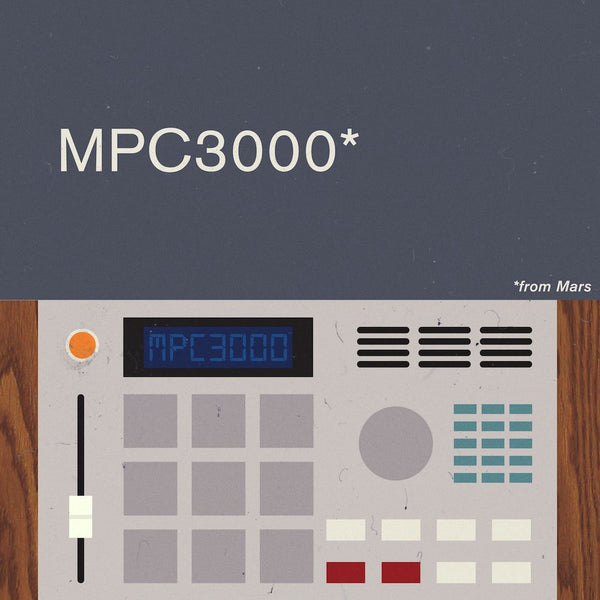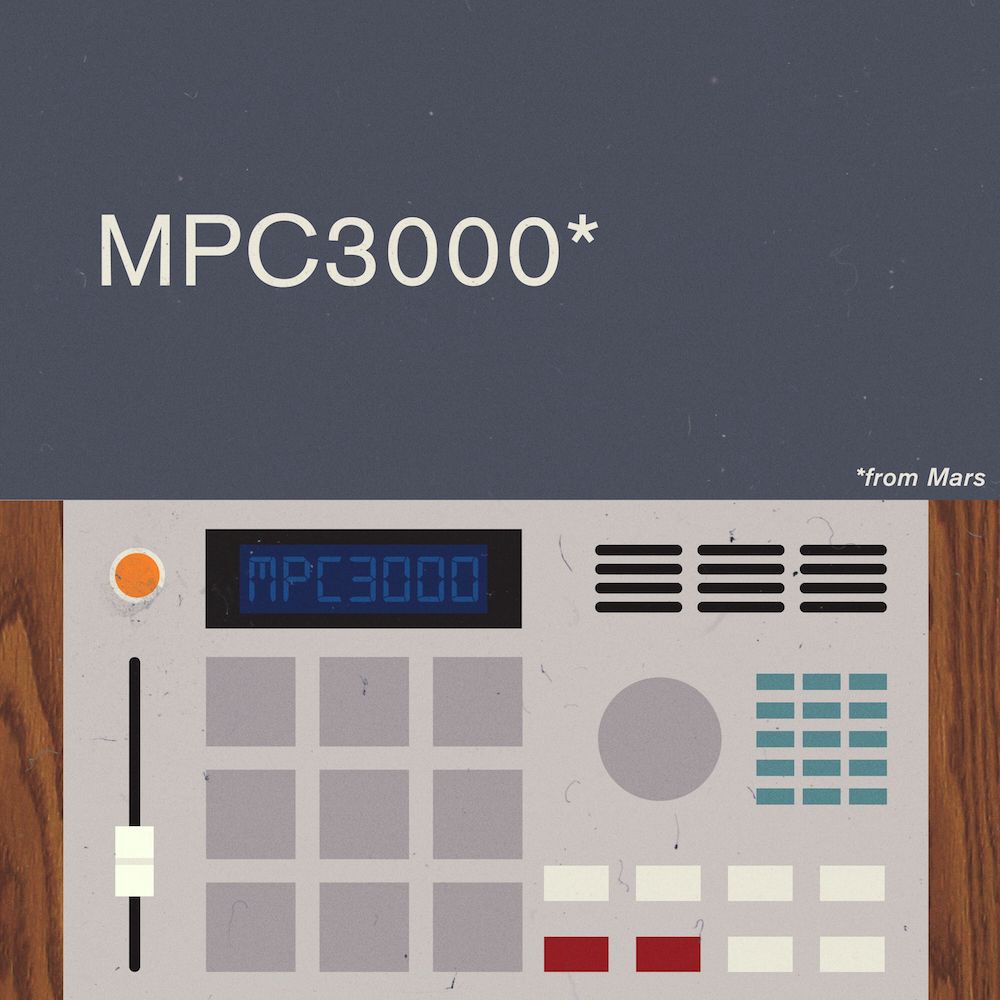MPC3000 FROM MARS
$29.00
Modern Drums From the Classic MPC
Making its debut in 1994 during the golden age of hip hop, the MPC3000 was the second and last collaboration between Roger Linn and Akai. It expanded on the MPC60 most notably with stereo, 16 bit sampling, a delay, and an excellent sounding filter with brilliant resonance and envelope modulation. Together with its signature sequencer groove and clippable input, this made the 3000 perfect for early 90s drum shaping, and became a genre-defining staple for producers like Dilla, Dr. Dre, and a multitude of lesser known Hip Hop, House and Techno producers.

What we Sampled Through the 3000
We sampled a wide variety of electronic and acoustic drums and percussion, along with some vinyl, carefully clipping, tuning and filtering on the MPC along the way. Processing sounds with additional hardware on the way in and out of the MPC, we aimed for a balance of color, tone, punch, and weight:
For our electronic drum sounds, we went straight to the source, plugging in classics like the 505, 626, 707, 808, 909, CR78, LM1, Lindrum Drumulator, and DMX, and recent acquisitions like the Minipops, an RZ1, OP1, Tempest, Kawai K1, ASR-10, M1, various Eurorack modules and Machinedrum.
We got everything from polite and punchy drums:
To fat, distorted madness:
For acoustic drums and percussion, we recorded a lot of stuff that lives in our studio - shakers, cabasas, hi hats, cymbals, clap, and kicks, rims and snares from our 1960s Rogers drum kit - with a vintage U87, Coles 4038, and Sennheiser MD 441. By editing these sounds in the MPC, the goal here was to blur the lines between electronic and acoustic sounds:
The Sampling Setup
Our process sampling the 3000 lasted months, and comprised of arduous sessions followed by extensive editing, organizing, deleting and repeating.
The setup was centered around the MPC and our API console. From the beginning, we knew we wanted this pack to be heavily processed, since a lot of our recent libraries have been pretty clean. So we grabbed our favorite compressors, saturators, EQs and pres. You can read the full gear list here.

By using aux sends, busses, and multiple channels on our console, we devised a complex signal chain of EQs, saturators, compressors, and tube preamps that we could switch into series or parallel quite easily. For each sound, we'd start with everything bypassed, and one by one, turn on only the processing we deemed necessary. This was mostly on the way into the MPC.
Sampling into the MPC
Recording into the 3000 with our trusty hum eliminator, we adjusted the input to taste. Going clean will give you the biggest transients, while hitting the AD a little hot will give you a huge amount of sustain and loudness. But too much, and you've ruined your sample. it's a precise game we play.
By engaging the lowpass filter and perfecting the resonance amount, envelope modulation amount, and filter decay, we were able to take even the dirtiest sounding drums from the processing above, and clean them up a bit. So, even though the processing was heavy handed, the samples retain their definition, with a huge amount of character:
Putting it all together
In the end we captured around 2,200 individual samples, and narrowed these down into a separate folder of (20) 16x hit kits for easy jamming. We also created (29) midi groove files based on the 3000's amazing sequencer. Try sequencing synths with them - it's magic. Finally, we mapped both the individual hits and kits to various DAWs and samplers. In Ableton, a macro will select the type of sample and various MPC tunings.

The Takeaway
The 3000 seems to be the perfect combination of sound and features in an MPC. While the 60 is indeed fatter sounding, it lacks the filter - which I consider vital to the MPC sound. And while the 2000 has more features, it is a bit colder in sound, with a smaller image. The 3000 sits perfectly in between these MPCs.
But none of these MPCs sounds better than the next, and don't let anybody tell you otherwise. They just sound different. So as far as sample packs go, it's really valuable to have access to all three, depending on the vibe you're after.
Contents:
- (2203) 24bit MPC 3000 WAV Samples
- (20) 16x Hit Kits for easy jamming
- (29) midi groove files from the MPC 3000 sequencer
- Tuned versions of BD Subs, Tonal Toms and Percussion hits
- Drum machines, acoustic drums and percussion and vinyl hits, meticulously sampled and processed through an API console and array of hardware
- Bass Drum, Rims, Claps, Snaps, Various Percussion, Tones, Toms, Bongos, Cymbals and more
- Korg Minipops, Casio RZ-1, DSI Tempest, TE OP-1, Octave The Cat, Kawai K1, ASR-10, Eurorack Modular, Volca Kick, Korg M1, 808, 909, LM1, DMX, and much more!
- 100% Hardware processing
- 336.1 MB Unzipped
- About
Formatting:
- Ableton includes (1) master drum rack containing all samples, and (20) additional pre-made kits racks.
- Kontakt, Logic EXS, Reason NNXT, and SFZ include: (315) Individual Hits Instruments and (20) Kits Instruments
- Maschine, Battery, FL Studio and Reason Kong include: (20) pre-made kits.
- MPC1000 and MPC2500 include: (20) pre-made kits on 5 programs
- MPC3000 includes: (20) pre-made kits on 5 programs
- MPC Live and MPC X include: (20) pre-made kits on 5 programs
- 336.1 MB Unzipped Requirements
Ready For:
- Any 24 bit WAV Compatible DAW or Sampler
- Ableton Live 9.7+ (Not Intro)
- Kontakt 5.6.5+ (Not Kontakt Player)
- Logic 9+
- Maschine 2.6+
- Reason 8+
- Battery 4.1.5+
- FL Studio 20.8+
- MPC1000, MPC2500, MPC3000, MPC Live, MPC X
Contents:
- (2203) 24bit MPC 3000 WAV Samples
- (20) 16x Hit Kits for easy jamming
- (29) midi groove files from the MPC 3000 sequencer
- Tuned versions of BD Subs, Tonal Toms and Percussion hits
- Drum machines, acoustic drums and percussion and vinyl hits, meticulously sampled and processed through an API console and array of hardware
- Bass Drum, Rims, Claps, Snaps, Various Percussion, Tones, Toms, Bongos, Cymbals and more
- Korg Minipops, Casio RZ-1, DSI Tempest, TE OP-1, Octave The Cat, Kawai K1, ASR-10, Eurorack Modular, Volca Kick, Korg M1, 808, 909, LM1, DMX, and much more!
- 100% Hardware processing
- 336.1 MB Unzipped
- About
Formatting:
- Ableton includes (1) master drum rack containing all samples, and (20) additional pre-made kits racks.
- Kontakt, Logic EXS, Reason NNXT, and SFZ include: (315) Individual Hits Instruments and (20) Kits Instruments
- Maschine, Battery, FL Studio and Reason Kong include: (20) pre-made kits.
- MPC1000 and MPC2500 include: (20) pre-made kits on 5 programs
- MPC3000 includes: (20) pre-made kits on 5 programs
- MPC Live and MPC X include: (20) pre-made kits on 5 programs
- 336.1 MB Unzipped Requirements
Ready For:
- Any 24 bit WAV Compatible DAW or Sampler
- Ableton Live 9.7+ (Not Intro)
- Kontakt 5.6.5+ (Not Kontakt Player)
- Logic 9+
- Maschine 2.6+
- Reason 8+
- Battery 4.1.5+
- FL Studio 20.8+
- MPC1000, MPC2500, MPC3000, MPC Live, MPC X










